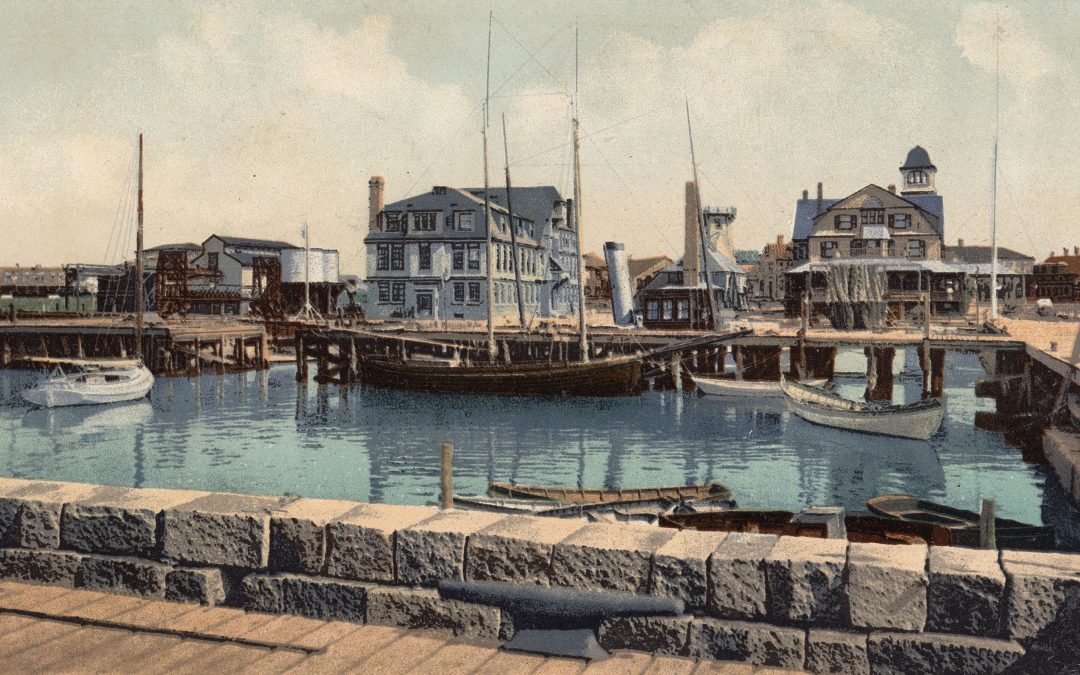By DEBORAH G. SCANLON
In June of 1871, Spencer Fullerton Baird, assistant secretary of the Smithsonian Institution and newly appointed US Commissioner of Fisheries, arrived in Woods Hole to set up the nation’s first Fisheries laboratory.
The 150th anniversary of the establishment of what is now known as National Marine Fisheries Service of the National Oceanic and Atmospheric Administration, informally known as NOAA Fisheries, also marks the beginning of the world-renowned scientific community that exists in Woods Hole.
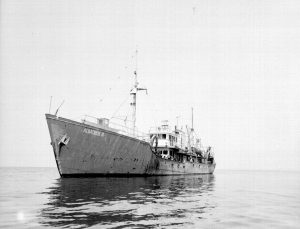
(Photo courtesy National Marine Fisheries Service)
Albatross III served from 1948-1959. The research vessel made 128 cruises during its Fisheries career, including a 1949 trip with Rachel Carson, the first woman to go to sea on the ship. The cruise inspired Ms. Carson to write “The Sea Around Us.”
Mr. Baird, a zoologist, first came to the village in 1863, combining vacation time with collecting marine organisms. He had been sent to Woods Hole to visit New England fisheries by Smithsonian director Joseph Henry, who was also developer of the American Lighthouse System and was involved in installing the Fresnel lens at Nobska Lighthouse.
Returning to Woods Hole in 1870, Mr. Baird became aware of the local fishermen’s concern about declining fish stock and lobbied Congress for funding to address the issue. He was successful in obtaining $5,000 for the study. He served without a salary because, due to his position at the Smithsonian, he was not allowed to collect two federal salaries at the same time.
Woods Hole had been selected by Mr. Baird for the US Fish Commission Laboratory for a number of reasons. It was centrally located within reach of fishing grounds, and as a deep-water port, it allowed access for research vessels. Its waters were productive, due to the confluence of the Gulf Stream and Cape Cod Bay, and were free of industrial pollution.
Based in a small building on Little Harbor that he borrowed from the Lighthouse board, Mr. Baird and volunteers set up a marine fish hatchery. Woods Hole native Vinal N. Edwards was hired as collector, the first permanent federal employee of the fisheries service, a position he held until his death in 1919. Mr. Edwards was not trained as a scientist but was described as an “intuitive naturalist.”
By 1885, they were successful enough to receive Congressional funding to expand, and with the help of Woods Hole philanthropist Joseph Story Fay and others, construction began for a new laboratory building, hatchery, residence for investigators and a protected boat basin on Great Harbor.
Included in that construction were two granite-lined pools used to house marine specimens. There was also a research aquarium to study the life history of various marine organisms and to raise marine fish in hopes of augmenting wild populations, according to the lab’s website, and to “further interest people in this work, Mr. Baird arranged for harbor seals to inhabit the open granite pools during the summer. They were re-released into the wild every fall. Even in those days, Cape Cod was a busy vacation destination. Mr. Baird set aside space in the aquarium for educational displays and opened its doors to the public daily during the season. It featured local sea life and exhibits to help people learn more about the sea around them. Visitors might also encounter a researcher or two, since it was also a working research aquarium.”
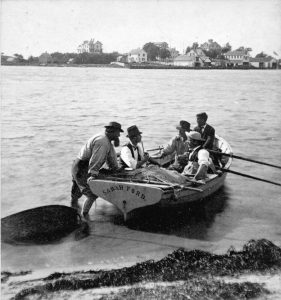
(Photo courtesy Woods Hole Historical Museum)
Spencer F. Baird (left) and collecting crew in the Sarah Ford in Little Harbor in the late 1870s.
Congress established the Fish Commission as an independent agency in 1888, a year after Mr. Baird’s death.
In 1888, the Marine Biological Laboratory was founded, located across the street from the Fisheries. The Fisheries staff provided fresh and salt water to the new lab, and a marine dock for its steamboat, Sagitta.
The Fish Commission functioned as an independent government agency until 1903, when it became the US Bureau of Fisheries and part of the Department of Commerce and Labor.
Among the early research projects that were undertaken at the Fisheries lab and resulted in long-term scientific references were Charles A. Wilson’s 1901 “The Copepods of the Woods Hole Region Massachusetts,” a standard reference in copepod biology; and A.E. Verrill’s 1908 study of the specimens collected during the survey that began at the Woods Hole lab in 1871. The project has formed the basis of hundreds of scientific papers on invertebrates.
In 1912 Henry B. Bigelow began 16 years of research on the oceanic fisheries in the Gulf of Maine. This fundamental work, along with extensive investigations with William B. Schroeder, resulted in the 1953 “Fishes of the Gulf of Maine,” a standard reference in the field. He went to sea on the Fisheries ships, and, although not an employee, he spent much time at the Fisheries.
He later became the first director of Woods Hole Oceanographic Institution, which was founded in 1930.
By 1917, World War I was affecting the lab’s operation, and for the next two years, it was not open for general investigations. R/V Albatross was transferred to the Navy for that time.
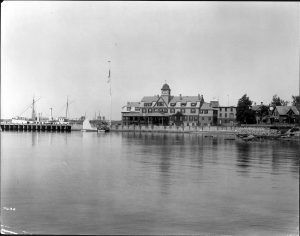
U.S.Fish Commission with Fish Hawk and spritsail boat at dock 1894
The Fisheries lab was back in operation after the war and a typical working day at the Fisheries during those years, as reported by Paul S. Galtsoff in “The Story of the Bureau of Commercial Fisheries Biological Laboratory,” usually started with a collecting trip to fish traps, or for dredging or taking plankton samples.
“The small coal-burning steamer Phalarope, under the command of Capt. R.N. Veeder, was used for this purpose.
“Fisheries biologists and MBL investigators interested in making a trip were welcome. A group desiring to get on board gathered by 9 AM at the Fisheries dock. Many persons wanting to watch the dredging or seining and were not concerned with obtaining the material…
“With the exception of long trips, which sometimes lasted the whole day, the Phalarope would return about noontime, early enough for the participants to change and be ready for their luncheon, which was served by the MBL mess hall sharply at 1:30 PM.
“The collecting trip became so popular, especially when the weather was good, that the number of passengers had to be restricted to conform with safety regulations…If something exciting happened during the trip, for instance the catch of a big shark or a large moonfish, everybody would dash to one side of the vessel and cause a dangerous list. In later years, Captain Veeder refused to take more than 20 persons aboard.”
In the next two decades, however, the lab was impacted by hurricanes and World War II, as well as a decrease in support. As Dr. Galtsoff wrote, “A steady decrease in research activities of the Fisheries laboratory began in 1932 and continued for many years…The long established policy of the Bureau in supporting basic research in marine sciences established by Baird began to decline and no clear-cut policy with regard to use of the station was formulated.”
The 1938 hurricane struck Woods Hole with a storm surge of over 10 feet, and the Fisheries pier was destroyed. The buildings sustained damage but equipment and boats were relatively undamaged. Buildings were later repaired but the seawall and wharf were not.
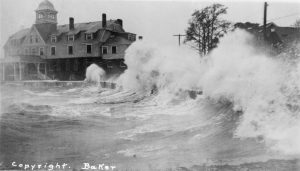
Damage to the seawall next to Fisheries during 1938 hurricane
In 1941, due to World War II, the lab was closed, and the buildings occupied by the Navy until the spring of 1944. Some scientific work continued in space borrowed from the MBL.
“During the war years, Woods Hole presented an unfamiliar picture,” Dr. Galtsoff wrote. “The Fisheries grounds and adjacent buildings of the MBL were surrounded by a high fence, and became inaccessible to civilians.”
And in 1944, a second hurricane struck Woods Hole, doing more serious damage to the lab than the 1938 storm, with sea water six feet above the street level, destroying the docks, part of the seawall, and damaging buildings.
The lab was sufficiently restored by 1947, Dr. Galtsoff wrote. In 1948, with the new R/V Albatross III commissioned, the outlook was more positive.
Yet another hurricane, Carol, struck Woods Hole 10 years after the one in ’44, destroying much of the lab and its environs, the saltwater pipes and pumps, and resulting in closure of the public aquarium for several years. The badly damaged laboratory and aquarium were torn down in 1958 and in 1962, the new lab was dedicated, a three-story building with laboratories, offices, a scientific library, and a second building with maintenance facilities and a new aquarium.
The popular Woods Hole Science Aquarium, in the same location, is the country’s oldest marine aquarium, featuring animals of the Northeast and mid-Atlantic waters, exhibits, information about Woods Hole science and history, fishery science, marine mammals, sea turtles, and local fish species, and touch tanks. It is still closed due to the pandemic, but lab officials are hopeful it will reopen soon.
The Woods Hole Fisheries lab, part of the nation’s first environmental conservation agency, and the oldest marine research laboratory in the world, maintains Spencer Baird’s legacy. Since its establishment, the Woods Hole lab has “conducted a comprehensive marine science program, studying fishery species and fisheries, monitoring and modeling ocean conditions and habitats, developing aquaculture, and providing reliable advice for policymakers.” Its work “promotes recovery and long-term sustainability of marine life in the region and helps sustain coastal communities.”
Woods Hole Fisheries Lab director Jon Hare will give a talk for the Woods Hole Historical Museum on June 9. The public is invited to this Zoom event; registration is on woodsholemuseum.org.

